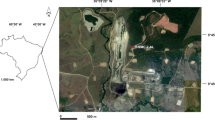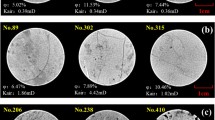Abstract
Thick tight Ordovician carbonate rocks are present at depths exceeding 5300 m in the Tahe oilfield and their matrix is considered to contain no storage space. An integrated petrographical and petrophysical study was conducted on a set of 25 tight carbonate core samples from Ordovician strata, covering a wide range of lithologies and textures. Six carbonate rock types were characterized by integrating both petrographical and petrophysical data, including thin-section observations and porosity, permeability, mercury injection capillary pressure and nuclear magnetic resonance (NMR) measurements. We found that thick grainstone and limestone with half-filled fractures exhibited good reservoir properties. NMR testing is an invaluable tool for characterizing pore structures in tight carbonate rocks. For example, six rock types can be identified from the NMR T2 distributions and the changes in pore volume under different pressures (up to 20 MPa) can be calculated. NMR technology can be used to perform rapid and accurate rock-type identification and pore network evaluation in tight carbonate rocks. The results provide an experimental foundation for NMR logging interpretations and advance the understanding of geological and geophysical characteristics of ultra-deep carbonate reservoirs.








Similar content being viewed by others
References
C. Rühl, BP statistical review of world energy 2007. ©BP (2007)
W. Zhao, S. Hu, L. Wei, T. Wang, Y. Li, Nat. Gas Ind. 1, 14–23 (2014)
G.Y. Zhu, M. Wang, T.W. Zhang, Identification of polycyclic sulfides hexahydrodibenzothiophenes and their implications for heavy oil accumulation in ultra-deep strata in Tarim Basin. Mar. Pet. Geol. 78, 439–447 (2016)
F. Tian, Q. Jin, X. Lu, Y. Lei, L. Zhang, S. Zhang, Mar. Pet. Geol. 69(1), 53–73 (2016)
X. Lu, Y. Wang, F. Tian, X. Li, D. Yang, T. Li, Mar. Pet. Geol. 86, 587–605 (2017)
H. Zeng, R. Loucks, X. Janson, G. Wang, Y. Xia, B. Yuan, AAPG Bull. 95(12), 2061–2083 (2011)
S.Z. Sun, Z. Liu, N. Dong, Y. Zhang, L. Yu, P. Wang, in Society of Exploration Geophysicists Annual Meeting (New Orleans, USA, 18–23 October 2015), p. 2821–2825
Q. Jin, F. Tian, J. Chin. Univ. Pet. 37, 515–521 (2013)
Q. Jin, F. Tian, H. Zhang, Acta Pet. Sin. 36(7), 791–798 (2015)
A.R. Adebayo, M.E. Kandil, T.M. Okasha, M.L. Sanni, Int. J. Greenhouse Gas Control 63, 1–11 (2017)
G. Mariappan, N. Sundaraganesan, Spectrochim Acta A 110(6), 169–178 (2013)
X. Ge, Y. Fan, Y. Cao, Appl. Magn. Reson. 45(2), 155–167 (2014)
M. Claverie, C. Reynaud, in SPE Europec Featured at 78th EAGE Conference and Exhibition (Vienna, Austria, 30 May-2 June 2016), SPE-180182-MS
F. Deng, L. Xiao, M. Wang, Appl. Magn. Reson. 47(11), 1–15 (2016)
U. Farooq, R. Iskandar, E.S.M. Radwan, M.A.H. Hozayen, in Abu Dhabi International Petroleum Exhibition and Conference (Abu Dhabi, UAE, 10-13 November, 2014), SPE-171932-MS
Y. Li, in Society of Exploration Geophysicists Rock Physics & Borehole Geophysics Workshop (Beijing, China, 28-30 August, 2016), p. 56–59
B. Vik, K.E. Sylta, A. Skauge, Transp. Porous Media 93(3), 561 (2012)
M.F. Rezende, S.N. Tonietto, M.C. Pope, AAPG Bull. 97(11), 2085–2101 (2013)
Z.L. He, S.T. Peng, T. Zhang, Oil Gas Geol. 31(6), 743–752 (2010)
F. Tian, X. Lu, S. Zheng, H. Zhang, Y. Rong, D. Yang, Open Geosci. 9, 266–280 (2017)
T.A. Cheema, C.Y. Lee, G.M. Kim, J.G. Hong, M.K. Kwak, C.W. Park, Int. J. Precis. Eng. Manuf. 15(7), 1405–1410 (2014)
O. Faÿ-Gomord, J. Soete, K. Katika, S. Galaup, B. Caline, F. Descamps, Mar. Pet. Geol. 75, 252–271 (2016)
E. Grunewald, R. Knight, Geophysics 74, 215–221 (2009)
W.E. Kenyon, Soc. Petrophys. Well Log Anal. 38, 21–43 (1997)
B. Vincent, M. Fleury, Y. Santerre, B. Brigaud, NMR relaxation of neritic carbonates: an integrated petrophysical and petrographical approach. J. Appl. Geophys. 74, 38–58 (2011)
X.M. Ge, Y.R. Fan, Y.F. Xiao, J.Y. Liu, D.H. Xing, D.N. Gu, S.G. Deng, Quantitative evaluation of the heterogeneity for tight sand based on the nuclear magnetic resonance imaging. J. Nat. Gas Sci. Eng. 38, 74–80 (2017)
R.J. Dunham, Classif. Carbonate Rocks 1, 108–121 (1962)
F.F. Wang, T.Z. Tang, T.Y. Liu, H.N. Zhang, Appl. Magn. Reson. 47(4), 1–13 (2016)
M. Liu, R. Xie, C. Li, L. Gao, Appl. Magn. Reson. 48(4), 1–21 (2017)
Z. Yang, Y. Zhang, H. Li, X. Zheng, Q. Lei, Earth Sci. 42(8), 1333–1339 (2017)
F. Rashid, P.W.J. Glover, P. Lorinczi, D. Hussein, R. Collier, J. Lawrence, Permeability prediction in tight carbonate rocks using capillary pressure measurements. Mar. Pet. Geol. 68, 536–550 (2015)
X.M. Ge, Y.R. Fan, J.T. Li, M.A. Zahid, Pore structure characterization and classification using multifractal theory—An application in Santanghu basin of western China. J. Pet. Sci. Eng. 127, 297–304 (2015)
Acknowledgements
This study was supported by National Basic Research Program of China (973 Program, Grant No. 2015CB250902), the Strategic Priority Research Program of the Chinese Academy of Sciences (Grant No. XDA14040404), the Chinese National Major Fundamental Research Developing Project (Grant No. 2017ZX05008-004), the Chinese National Natural Science Foundation (Grant Nos. 41502149, and U1663204) and the China Postdoctoral Foundation Funded Project (Grant No. 2015M570148). We are deeply grateful to the Tahe Oilfield Branch Company SINOPEC for supplying the data and allowing this paper to be published. We thank two anonymous reviewers for their thorough and critical reviews and suggestions, which have improved the manuscript.
Author information
Authors and Affiliations
Corresponding author
Rights and permissions
About this article
Cite this article
Tian, F., Wang, W., Liu, N. et al. Rock-Type Definition and Pore Characterization of Tight Carbonate Rocks Based on Thin Sections and MICP and NMR Experiments. Appl Magn Reson 49, 631–652 (2018). https://doi.org/10.1007/s00723-018-0993-2
Received:
Revised:
Published:
Issue Date:
DOI: https://doi.org/10.1007/s00723-018-0993-2




